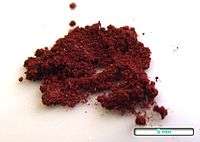Acriflavine
 | |
 Sample of pure acriflavine | |
| Names | |
|---|---|
| IUPAC name
3,6-Diamino-10-methylacridin-10-ium chloride | |
| Other names
Acriflavinium chloride (INN) | |
| Identifiers | |
| 3D model (JSmol) |
|
| ChEBI | |
| ChemSpider | |
| EC Number | 201-668-8 |
| PubChem CID |
|
| UNII | |
| |
| |
| Properties | |
| C14H14ClN3 | |
| Molar mass | 259.74 g·mol−1 |
| Pharmacology | |
| R02AA13 (WHO) QG01AC90 (WHO) | |
| Except where otherwise noted, data are given for materials in their standard state (at 25 °C [77 °F], 100 kPa). | |
| | |
| Infobox references | |
Acriflavine (INN: acriflavinium chloride) is a topical antiseptic. It has the form of an orange or brown powder. It may be harmful in the eyes or if inhaled. It is a dye and it stains the skin and may irritate. The hydrochloride form is more irritating than the neutral form. It is derived from acridine. Commercial preparations are often mixtures with proflavine.[1] It is known by a variety of commercial names.
Uses
Medical use
Acriflavine was developed in 1912 by Paul Ehrlich, a German medical researcher, and was used during the First World War against sleeping sickness and as a topical antiseptic.[2]
Other uses
Acriflavine is used in biochemistry for fluorescently labeling high molecular weight RNA.[1]
It is used as treatment for external fungal infections of aquarium fish.[3]
Research
In an animal model, acriflavine has been shown to inhibit HIF-1, which prevents blood vessels growing to supply tumors with blood and interferes with glucose uptake and use.[4]
Acriflavine might be effective in fighting common cold virus, and also aid the fight against increasingly antibiotic resistant bacteria.[5][6][7]
Legal status
Australia
Acriflavine is a controlled substance in Australia and dependent on situation, is considered either a Schedule 5 (Caution) or Schedule 7 (Dangerous Poison) substance. The use, storage and preparation of the chemical is subject to strict state and territory laws.
References
- 1 2 "Acriflavine". Sigma-Aldrich.
- ↑ acriflavine Encyclopædia Britannica
- ↑ Acriflavine use in aquaria
- ↑ Lee, K.; Zhang, H.; Qian, D. Z.; Rey, S.; Liu, J. O.; Semenza, G. L. (2009). "Acriflavine inhibits HIF-1 dimerization, tumor growth, and vascularization". Proceedings of the National Academy of Sciences. 106 (42): 17910. PMC 2764905
 . PMID 19805192. doi:10.1073/pnas.0909353106.
. PMID 19805192. doi:10.1073/pnas.0909353106. - ↑ "Antiseptic used in WWI could hold key to treating superbugs, viral infections, Melbourne researchers say". ABC. November 28, 2016.
- ↑ "This forgotten WWI antiseptic could be the key to fighting antibiotic resistance". Science Alert. November 30, 2016.
- ↑ "Activation of cGAS-dependent antiviral responses by DNA intercalating agents". Nucleic Acids Research. 45: 198–205. 2016. doi:10.1093/nar/gkw878.